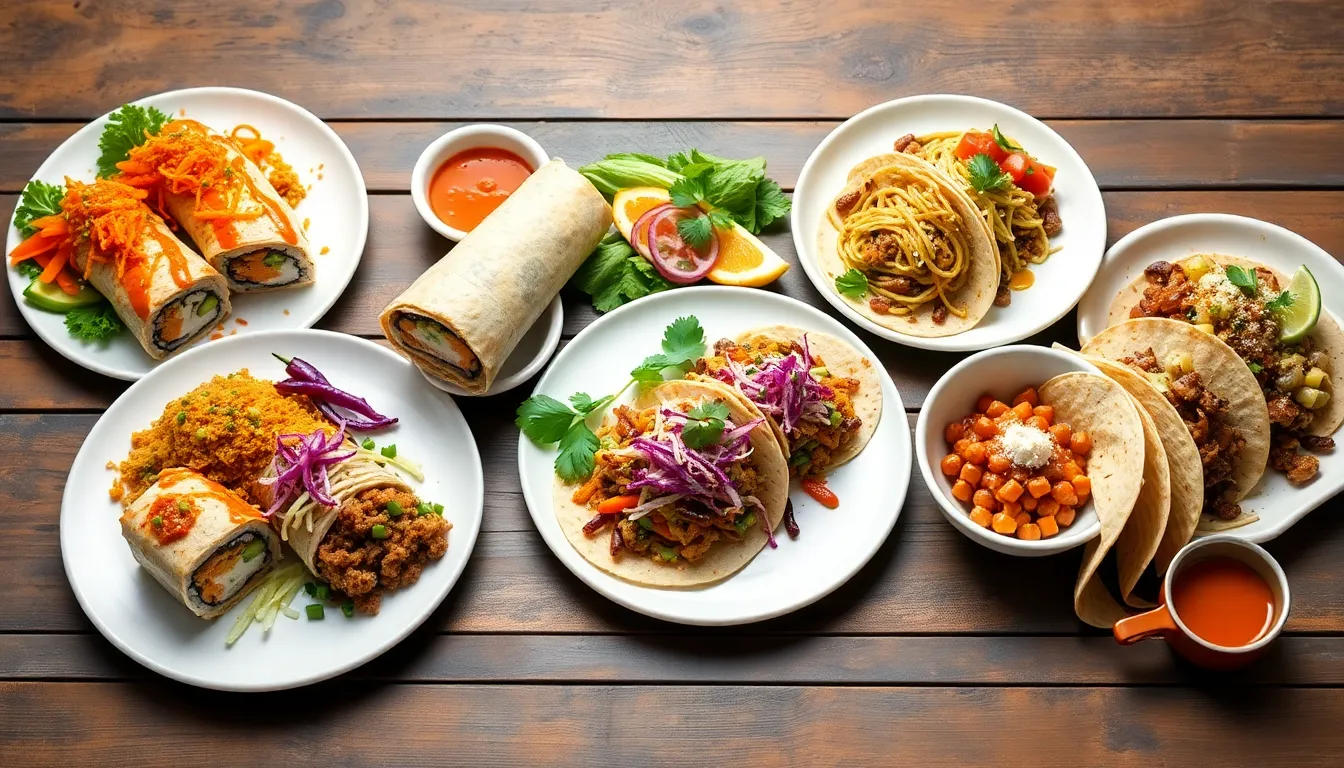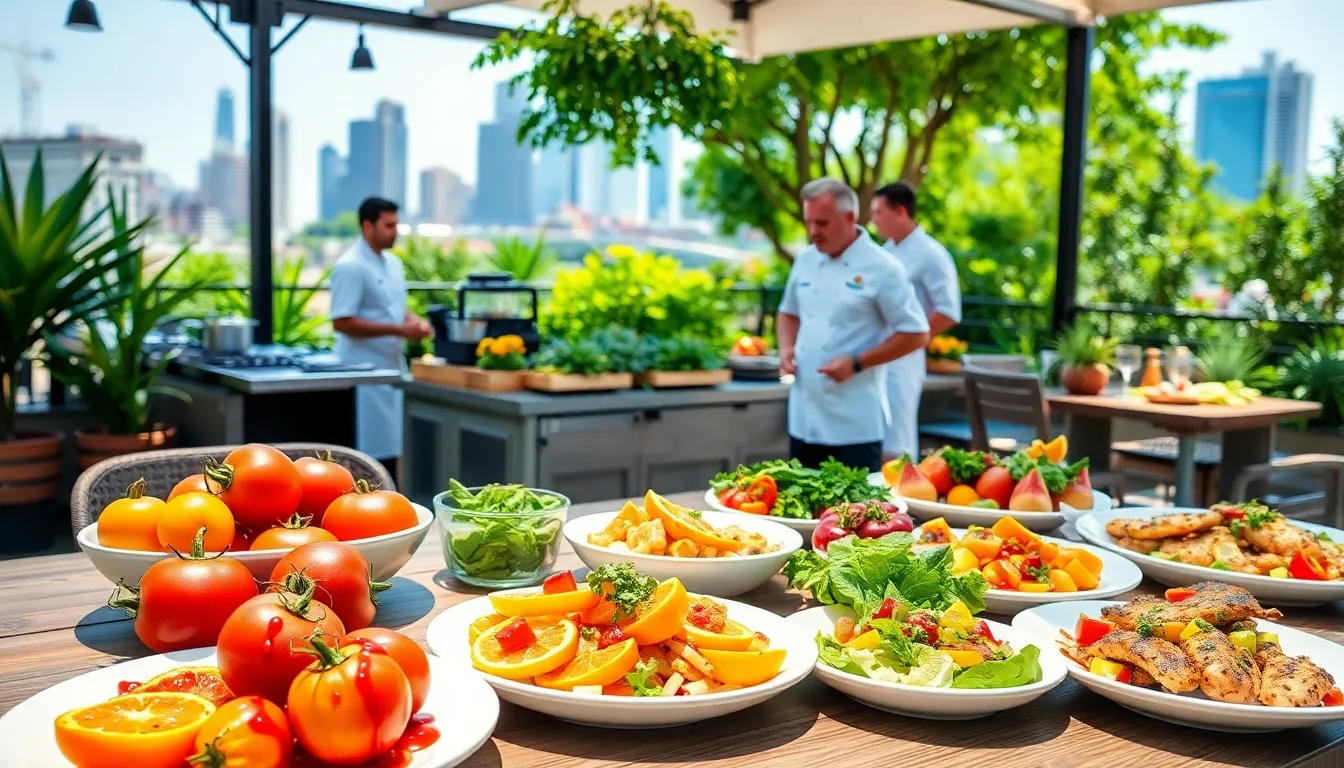Table of Contents
ToggleImagine biting into a taco filled with sushi or savoring a pizza topped with kimchi. Fusion food is where culinary boundaries dissolve and flavors collide in a delicious dance. This innovative cuisine takes the best of diverse culinary traditions and creates mouthwatering masterpieces that leave taste buds tingling and diners craving more.
What Is Fusion Food?
Fusion food blends culinary traditions from various cultures, resulting in innovative dishes that excite the palate. This creative approach to cooking combines flavors and techniques, transforming the dining experience.
Definition and Concept
Fusion food refers to a culinary style that merges elements from different gastronomies. Chefs often create unique recipes that showcase distinct cultural ingredients. Popular examples include miso-glazed eggplant and curry risotto. The concept thrives on experimentation, allowing chefs to reinterpret traditional dishes. Through this process, unexpected flavor profiles emerge, appealing to adventurous diners.
History and Origins
Fusion cuisine traces its roots to globalization and increased cultural exchange. Major cities like Los Angeles and New York City became focal points for this culinary evolution in the late 20th century. Influences from various cultures intersected, leading to innovative dining experiences. As chefs experimented, the movement gained popularity, creating new classics. Today, fusion food reflects diverse backgrounds and the innovative spirit of modern gastronomy.
Popular Types of Fusion Food

Fusion food encompasses a range of exciting culinary combinations. It invites experimentation and creativity, resulting in memorable dining experiences.
Asian-Fusion Dishes
Asian-fusion dishes feature vibrant flavors and diverse ingredients. Sushi burritos combine fresh sushi components with the portability of a burrito. Pad Thai tacos offer a twist on traditional flavors, wrapping stir-fried noodles in a crunchy shell. Another example is kimchi fried rice, where Korean kimchi meets classic fried rice, enhancing umami taste. These inventive recipes showcase the versatility of Asian ingredients in new contexts.
Mexican-Fusion Creations
Mexican-fusion creations celebrate bold flavors and inventive techniques. Korean BBQ tacos blend marinated meats with fresh toppings for a satisfying bite. Nacho sushi integrates sushi rolls with classic nacho elements, creating a fun and shareable dish. Another popular dish is mole enchiladas, where rich mole sauce enhances traditional enchiladas with layers of flavor. These dishes highlight the adaptability of Mexican cuisine and its compatibility with other culinary traditions.
Benefits of Fusion Food
Fusion food offers a range of benefits that enhance culinary experiences. It allows for creativity in the kitchen, resulting in dishes that surprise and delight.
Culinary Innovation
Culinary innovation thrives in fusion food. Chefs combine techniques and ingredients from various cultures to create new flavors. Unique dishes emerge, like matcha-infused pancakes or spicy pho-inspired ramen. Diners enjoy excitement and variety when trying these innovative meals. Such creativity pushes traditional boundaries and encourages a spirit of experimentation within the culinary world. By blending tastes, methods, and presentations, fusion food keeps menus fresh and appealing.
Cultural Exchange
Cultural exchange remains a key benefit of fusion food. It fosters appreciation for diverse culinary traditions and ingredients. Through fusion cuisine, people discover the flavors of different cultures, such as combining Indian spices in a Mexican tortilla. This sharing of culinary heritage promotes understanding and connection among various communities. Diners not only sample exciting combinations but also learn about the origins of the ingredients used. Fusion food serves as a platform for celebrating cultural diversity while enhancing global food experiences.
Challenges in Creating Fusion Food
Creating fusion food presents unique challenges, particularly in flavor and authenticity.
Balancing Flavors
Achieving balance in fusion dishes proves crucial. Chefs often face the task of harmonizing distinct flavors from different cuisines. For instance, combining spicy and sweet elements can enhance a dish but risks overpowering each ingredient’s unique characteristics. Mastering this interplay between flavors requires an understanding of culinary techniques and ingredient profiles. Successful fusion dishes, such as pineapple fried rice or spicy mango salsa, illustrate how complementary tastes can create a delightful experience. Chefs must continuously experiment to refine their recipes and ensure every flavor contributes to a cohesive profile.
Maintaining Authenticity
Preserving authenticity in fusion cuisine remains a significant hurdle. Many chefs grapple with finding the right balance between creativity and honoring traditional recipes. Culinary traditions carry cultural significance, and altering classic dishes can lead to resistance from culinary purists. Adapting a traditional dish, like recreating tamales with Asian fillings, may resonate with some diners but alienate others. Understanding the roots of the ingredients becomes essential for chefs. Authenticity cannot be sacrificed, even while forging new culinary paths. Careful navigation of these challenges fosters appreciation for both the old and the new in the culinary world.
Fusion food stands as a testament to culinary creativity and cultural exchange. It invites diners to explore a world where flavors intertwine and traditions merge. As chefs continue to innovate and push boundaries, the dining experience becomes a celebration of diversity and imagination.
With each unique dish, fusion cuisine not only tantalizes taste buds but also fosters a deeper appreciation for global culinary heritages. The journey of fusion food highlights the importance of balance and authenticity, ensuring that every bite tells a story. As this culinary trend evolves, it promises to keep inspiring both chefs and food lovers alike.




